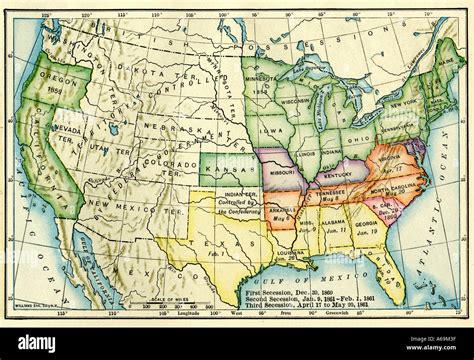Map Of United States In 1860

The year 1860 was a pivotal moment in the history of the United States, marking the eve of the American Civil War. The country was divided, with deep-seated tensions between the northern and southern states over issues such as slavery, states' rights, and economic and cultural differences. The map of the United States in 1860 reflects this division, showcasing the 33 states that made up the Union at the time, as well as the various territories and areas that were not yet states.
A closer examination of the map reveals the stark contrast between the industrialized North and the agricultural South. The North, comprising states such as New York, Pennsylvania, and Ohio, was characterized by its dense population, extensive railroad networks, and thriving manufacturing sectors. In contrast, the South, including states like Virginia, Georgia, and Alabama, was predominantly rural, with economies heavily reliant on agriculture and slavery. This divide would ultimately contribute to the outbreak of the Civil War, as the North and South clashed over their fundamentally different visions for the country's future.
Geographical Overview

The map of the United States in 1860 also highlights the country’s vast geographical expanses, including the Great Plains, the Rocky Mountains, and the Mississippi River Valley. The Great Plains, stretching across present-day states like Kansas, Nebraska, and the Dakotas, were still largely unsettled, with only a few scattered settlements and trading posts. The Rocky Mountains, spanning parts of modern-day Colorado, Utah, and Wyoming, posed a significant barrier to westward expansion, while the Mississippi River Valley, encompassing areas around the Mississippi River, was a vital transportation route and hub of commercial activity.
Key Points
- The United States consisted of 33 states in 1860, with the most recent additions being Minnesota (admitted in 1858) and Oregon (admitted in 1859).
- The country was divided into the northern and southern states, with the North being more industrialized and the South relying heavily on agriculture and slavery.
- The map highlights the significance of geographical features like the Great Plains, the Rocky Mountains, and the Mississippi River Valley in shaping the country's development and expansion.
- The year 1860 marked a critical juncture in American history, as the country teetered on the brink of the Civil War, which would ultimately result in the abolition of slavery and a more unified federal government.
- The map also underscores the importance of understanding the historical context of the United States in 1860, including the political, social, and economic factors that contributed to the outbreak of the Civil War.
State and Territorial Boundaries
A detailed examination of the map reveals the intricate network of state and territorial boundaries. The northern states, including Maine, New Hampshire, and Vermont, shared borders with British North America (now Canada), while the southern states, such as Florida, Alabama, and Mississippi, bordered the Gulf of Mexico and the Atlantic Ocean. The western territories, including present-day California, Nevada, and Utah, were still in the process of being settled and organized, with many areas remaining under the control of Native American tribes.
| State/Territory | Admission Year | Population (1860) |
|---|---|---|
| Maine | 1820 | 628,279 |
| New Hampshire | 1790 | 326,073 |
| Vermont | 1791 | 315,098 |
| Massachusetts | 1788 | 1,231,066 |
| Rhode Island | 1790 | 174,620 |

Historical Context and Significance

The map of the United States in 1860 is more than just a geographical representation of the country; it is a window into the historical context and significance of the time. The year 1860 marked a critical juncture in American history, as the country teetered on the brink of the Civil War. The election of Abraham Lincoln as President in November 1860 would ultimately lead to the secession of 11 southern states and the formation of the Confederate States of America. The Civil War, which lasted from 1861 to 1865, would result in the deaths of an estimated 620,000 to 750,000 soldiers and civilians and the emancipation of four million enslaved African Americans.
The map also highlights the significance of westward expansion and the concept of Manifest Destiny, which held that the United States was destined to expand its territory across North America. The Kansas-Nebraska Act of 1854, which allowed new states to decide for themselves whether to allow slavery, had set the stage for the violent conflicts in the Kansas territory, known as "Bleeding Kansas." The map showcases the intricate network of roads, trails, and railroads that facilitated westward expansion, including the Oregon Trail, the California Trail, and the Pony Express.
Transportation and Communication
The map of the United States in 1860 also underscores the importance of transportation and communication in shaping the country’s development. The construction of the transcontinental railroad, which began in 1863 and was completed in 1869, would revolutionize transportation and commerce across the country. The map highlights the significance of rivers, such as the Mississippi, Ohio, and Missouri, which served as vital transportation routes and hubs of commercial activity. The telegraph, which was introduced in the 1830s, had also become a crucial means of communication, facilitating the exchange of information and ideas across the country.
What were the main causes of the Civil War?
+The main causes of the Civil War were the disagreement over slavery, states' rights, and economic and cultural differences between the North and South.
How did the Civil War affect the United States?
+The Civil War resulted in the deaths of an estimated 620,000 to 750,000 soldiers and civilians, the emancipation of four million enslaved African Americans, and a more unified federal government.
What was the significance of westward expansion in the United States?
+Westward expansion was significant because it allowed the United States to expand its territory, establish new trade routes, and spread its influence across North America.
In conclusion, the map of the United States in 1860 is a powerful tool for understanding the country’s complex and often tumultuous history. By examining the geographical, political, and social landscape of the time, we can gain a deeper understanding of the events that shaped the nation and continue to influence its development today. The map serves as a poignant reminder of the importance of understanding the historical context and significance of the time, and its relevance to the present day.



